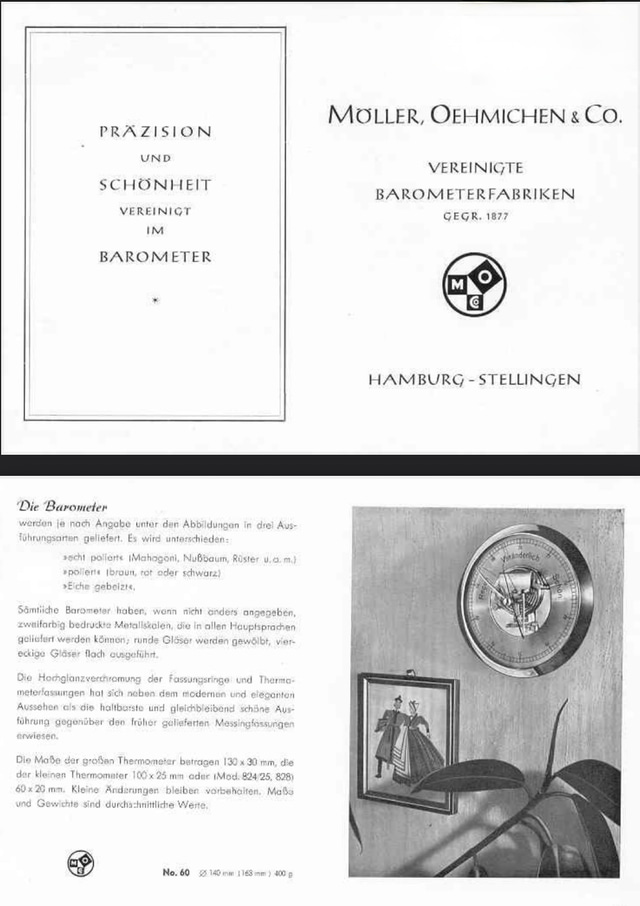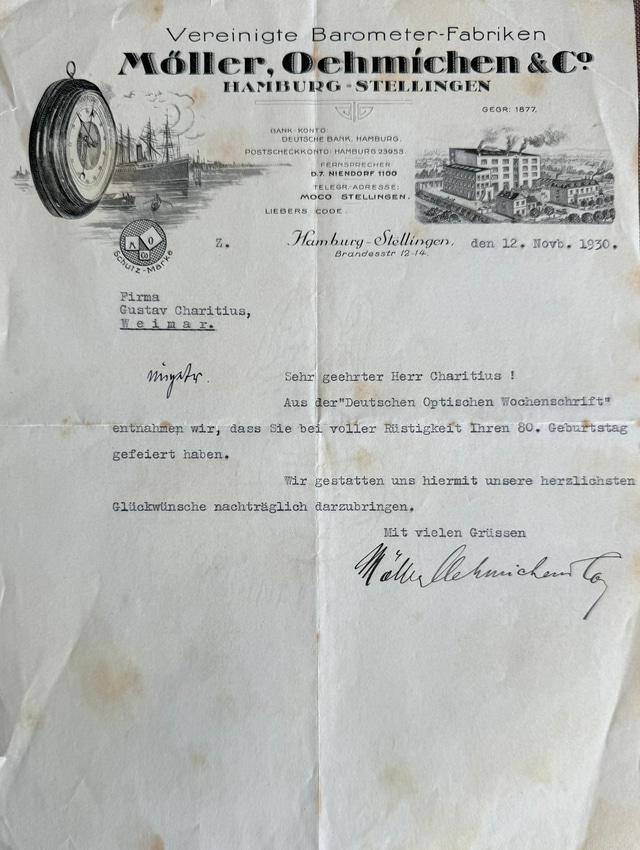

The History of Möller, Oehmichen & Co (MOCO) – Hamburg-Stellingen
The company MOCO traces its origins to Georg Henry Siegmund Oscar Möller, who founded the enterprise in 1876. Georg Möller was a skilled precision instrument mechanic who began his career at a time when traditional mercury barometers were gradually being replaced by the new, safer aneroid barometers. Before founding his own firm, Möller had gained experience in instrument making—possibly working with scientific manufacturers of the time—which allowed him to master what was then a pioneering technology.
In 1876, he established a workshop in Stellingen, which at that time was an independent village located between Hamburg and Altona. This rural district, northwest of Hamburg’s center, belonged to the Duchy of Holstein, and was under Danish, and later Prussian, jurisdiction. When Möller registered the firm “in Stellingen,” it meant registration in a separate administrative district, likely tied to the Hamburg trade register. This explains why historical documents sometimes describe a confusing mix: “firm in Stellingen,” “registered in Hamburg,” or “listed in the Altona address book” (since Altona was the nearest urban center).
Originally, the company operated under the name “Möller & Sander”, reflecting Möller’s partnership with a man named Sander.
“Möller & Sander, barometer factory, Friedenstraße 54. Specializing in metallic barometers.” (Engineering, Vol. 195, January–June 1963. London: 36 Bedford Street, London W.C.2.)
From the very beginning, the firm specialized in metallic barometers—that is, aneroid barometers, known for their compactness and safety compared to mercury-based instruments. Möller’s credo became “precision and beauty united in a barometer,” emphasizing both the scientific and aesthetic value of his products.
Georg Möller played a personal and active role in the firm’s development not only as an engineer-entrepreneur but also as a member of professional societies. He belonged to the German Society for Mechanics and Optics, where his work was highly regarded. Under his leadership, the company established itself as a prominent producer of high-precision barometers in northern Germany. Sadly, Möller died in April 1903 at the age of 55, a serious loss for the firm, although the foundations he laid were carried on by his successors.
“On April 23 of this year, our member Mr. J. H. Möller of the firm Möller & Sander in Altona passed away at the age of 55.” (Deutsche Mechaniker-Zeitung, 1903, Berlin: Verlag von Julius Springer.)
Möller’s initial partner, Sander, likely handled commercial or technical aspects of the business during its early phase. Though little is known about him, records confirm that under the brand “Möller & Sander,” the company operated successfully in the late 19th and early 20th centuries. After Möller’s death in 1903, Sander likely took over temporarily until new changes in ownership occurred.
One key figure in the company’s later history was Ernst Adolf Hieronymus Samtleben, born on September 6, 1879, and deceased on January 18, 1950. He was a trained engineer and entrepreneur who played a major role in the development of Möller, Oehmichen & Co. in the 20th century. Samtleben likely joined the company due to his engineering expertise, just as the firm was transitioning from trade into industrial-scale production.
Samtleben soon proved himself as a technical manager and organizer. On April 9, 1909, he was officially listed in the Hamburg trade register as a co-owner, alongside Oscar Möller (possibly a descendant of the founder). Records also show that Oscar Möller was active earlier, in 1878, as a commission agent and forwarding agent. On November 12, 1900, the firm was described as a barometer and optical goods wholesale manufacturer.
During this period, the company moved away from general trade and began focusing specifically on the production of aneroid barometers and optical measuring instruments. Samtleben’s engineering input helped refine the product line and expand production. By the late 1910s, Samtleben had become the chief technical director, laying the groundwork for further growth.
Following his entry into the business, the firm underwent major restructuring. On April 1, 1919, the company became a general partnership (Offene Handelsgesellschaft, OHG), and Johann Hinrich Möller—likely Oscar Möller’s son—was added as a registered partner. At that point, the firm adopted a new name: “Möller, Oehmichen & Co.”, abbreviated as MOCO. Samtleben remained as managing engineer and co-owner. While the Möller family maintained continuity, Samtleben took charge of production and product development.
The inclusion of the name Oehmichen in the company title has raised questions. Sources indicate that in 1919, the firm entered into some form of merger or partnership with a third party. Most likely, this involved the Oehmichen family, already active in the precision instrument trade. A Dresden-based firm named E. M. & A. Oehmichen, registered on February 2, 1929, at Blockhausgasse 3, was known for exporting clocks and precision devices (including their trademark “Paladin”). It is probable that the Oehmichen family contributed capital or distribution networks to the Hamburg-based factory.
Thus, the Oehmichen name in the firm’s title likely reflects a financial or commercial partnership, rather than involvement in production management in Stellingen. The addition of the name may have been part of a branding or merger agreement. Indeed, in the 1930s, the firm styled itself as “Vereinigte Barometer-Fabriken” (“United Barometer Factories”), suggesting a consolidation of resources.
In all likelihood, Oehmichen was a silent partner, as permitted under German commercial law at the time, which allowed non-managing shareholders to be included in the firm’s name (via the “& Co.” suffix). By the mid-20th century, “Oehmichen” had evolved into a legacy brand component rather than a reference to an active owner. The company continued using the MOCO brand, even after no Oehmichen family member was involved in its ownership or management.
Between 1919 and 1932, MOCO firmly established itself as a major barometer manufacturer. Its factory in Jaguarstieg 12, in the Stellingen district of Hamburg-Altona, expanded under Samtleben’s leadership to include household barometers and weather stations. By the early 1930s, the company even marketed itself as “United Barometer Factories Möller, Oehmichen & Co.”—a reflection of its growth and consolidation. In 1932, J. H. Möller left the company, leaving Samtleben as the sole active proprietor.
Throughout the early 20th century, MOCO regularly took part in industrial fairs and exhibitions. German instrument makers traditionally exhibited at the Leipzig Trade Fair, and later at the Hanover Industrial Fair. Archival records confirm that MOCO planned to exhibit at the 1904 World’s Fair in St. Louis (USA) as part of the German delegation of scientific instruments. This indicates that the company already sought international recognition, possibly facilitated by the Oehmichen family’s export networks, particularly in the Americas.
Although the Great Depression of the 1930s hit Germany less severely than the U.S., reduced purchasing power likely constrained sales of luxury instruments. Nevertheless, MOCO survived this period, probably due to its product quality and possible state contracts. As Germany prepared for war in the late 1930s and early 1940s, the firm likely received orders for altimeters, barographs, or airfield meteorological devices. During World War II, Hamburg suffered extensive bombings, including the Stellingen area in 1943. However, no record of MOCO’s factory destruction exists. On the contrary, the firm Möller, Oehmichen & Co. is listed in the British intelligence guide Bomber’s Baedeker (1944) as an active precision instrument plant, marking it as a strategic target.
After the war, the factory found itself in the British occupation zone. Some equipment or technology may have been confiscated or studied by the Allies, but the company managed to resume operations in the late 1940s.
In the 1950s and 1960s, MOCO experienced a new wave of success, fueled by West Germany’s post-war economic boom and the public’s interest in home weather stations. Alongside traditional barometers in carved wood, MOCO introduced stylish table and wall units in mid-century modern design, incorporating metals, plastics, and colored enamels.
The company received acclaim for its industrial design, winning the iF Design Award at the Hanover Fair in 1961 for one of its barometers. Additional design awards followed in 1963, affirming the brand’s reputation for combining precision and aesthetics. Promotional materials emphasized both qualities—one 1949 catalog described the firm’s products as “precise and beautiful,” and listed dozens of models with varying styles. By the 1950s and 1960s, MOCO’s catalogs featured full weather stations (barometer, thermometer, hygrometer), elegant desktop pieces, and round-face models. The company experimented with new materials—aluminum, stainless steel, acrylic—maintaining its leadership in the German weather instrument market.
The Stellingen factory employed many skilled workers, including descendants of prewar craftsmen. MOCO not only satisfied domestic demand but also exported extensively, particularly to North America and Western Europe. Many export models were branded simply “MOCO Germany,” a name already familiar abroad.
By the mid-1960s, however, the company faced growing competition from both established rivals (e.g. Lufft, Fischer) and Asian manufacturers. The onset of electronic instruments further challenged MOCO’s traditional offerings. Management likely recognized the need for either expansion or partnership.
In 1948, Samtleben officially became the sole owner, after the general partnership was dissolved. Following his death in January 1950, management passed to his widow Margarethe Samtleben, and in 1953, their son Peter Samtleben—an engineer and former authorized officer—took over. He converted the firm into a limited partnership (Kommanditgesellschaft, KG) to attract investment. The company remained in Stellingen until 1967, after which it relocated to Rellingen (Adlerstraße 47). The final recorded design awards were received in 1963, affirming the firm’s continued excellence.
In 1968, however, Möller, Oehmichen & Co. effectively ceased independent operations. The MOCO name no longer appeared in the market as a separate brand. The last products date from the late 1960s. The reasons for closure are undocumented, but likely include financial pressures or acquisition. Indeed, the firm’s assets and technologies were transferred to the American corporation Taylor Instrument. Taylor’s German subsidiary registered the former MOCO company as its branch.
The German commercial register lists:
On the website online-handelsregister.de, a more detailed entry is available:
“The company MOCO – Barometer Factory, Möller, Oehmichen & Co., a branch of Taylor Instrument Gesellschaft mit beschränkter Haftung (GmbH), is registered in the commercial register at the District Court of Pinneberg under the number HRB 471 PI. Its status is listed as ‘deleted’ (gelöscht). Currently, there are no up-to-date register publications available for this company. Official announcements were provided only up until August 2022.”
In other words, the MOCO brand was absorbed by Taylor Instrument, a U.S. company that had been producing thermometers and barometers since the mid-19th century. With this acquisition, Taylor gained a foothold in Europe via MOCO’s facilities in Hamburg. Production may have continued for a while under the Taylor name—perhaps using MOCO designs—but the original brand name disappeared. Eventually, the branch was liquidated, formally closing the book on the history of Möller, Oehmichen & Co.